Categories > Guides and Tips

The Ultimate Guide on Transportation in Thailand
Get ready to be whisked away to the land of smiles, where Thailand’s stunning natural beauty and rich cultural heritage await you! But with so much to see and do, getting around this amazing country can be a real adventure.
Fret not, as we’ve got the ultimate guide to all the transportation modes in Thailand! Our team of seasoned travellers has done the legwork, so you don’t have to. We’ll show you the ropes of each option, so you can choose the one that fits your style and budget.
Whether you’re a first-time visitor or a Thailand veteran, our guide will help you navigate the country like a pro. So buckle up, hold on tight, and let’s explore the wonders of Thailand together!
Tuk Tuk
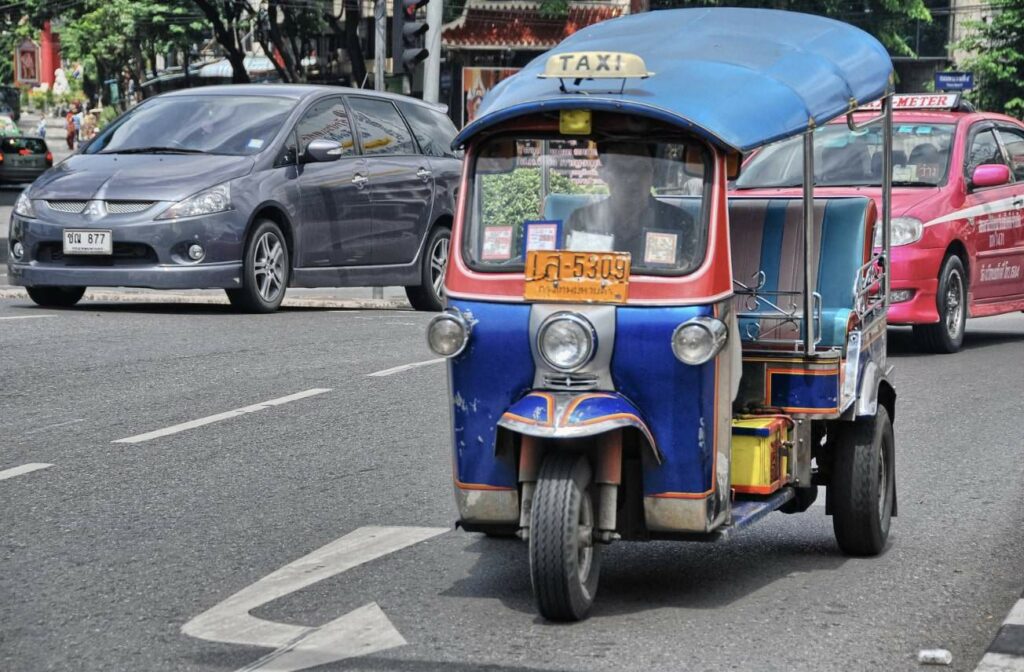
Tuk Tuks are one of the most popular and iconic modes of transportation in Thailand. These three-wheeled vehicles are found in many cities and are a fun way to experience the local culture.
They are small, open-air vehicles that can seat up to three passengers. They are commonly found on the busy streets of Bangkok, Chiang Mai, and other cities across Thailand.
These amazing vehicles are great for short distances and can easily weave through traffic, making them a convenient option for getting around.
Even for longer distances, the prices are still reasonable, with fares that could go up to 200-300 baht (approximately 6-9 USD).
| Tips for Riding Tuk-tuks in Thailand ⮕ Negotiate the fare before you get in Tuk Tuk fares are not regulated, so it’s important to negotiate the price before you start your journey. Be aware that Tuk Tuk drivers may try to overcharge you, especially if you’re a tourist. ⮕ Wear a helmet If your Tuk Tuk driver provides helmets, it’s a good idea to wear one, especially if you’re riding on busy streets. ⮕ Hold on tight Tuk Tuks can be a bumpy ride, so make sure to hold on tight and keep your belongings secure. ⮕ Be prepared for the elements Tuk Tuks are open-air vehicles, so you may be exposed to the sun, rain, or wind. Dress appropriately for the weather and bring sunscreen, a hat, or a rain jacket if necessary. |
Taxi
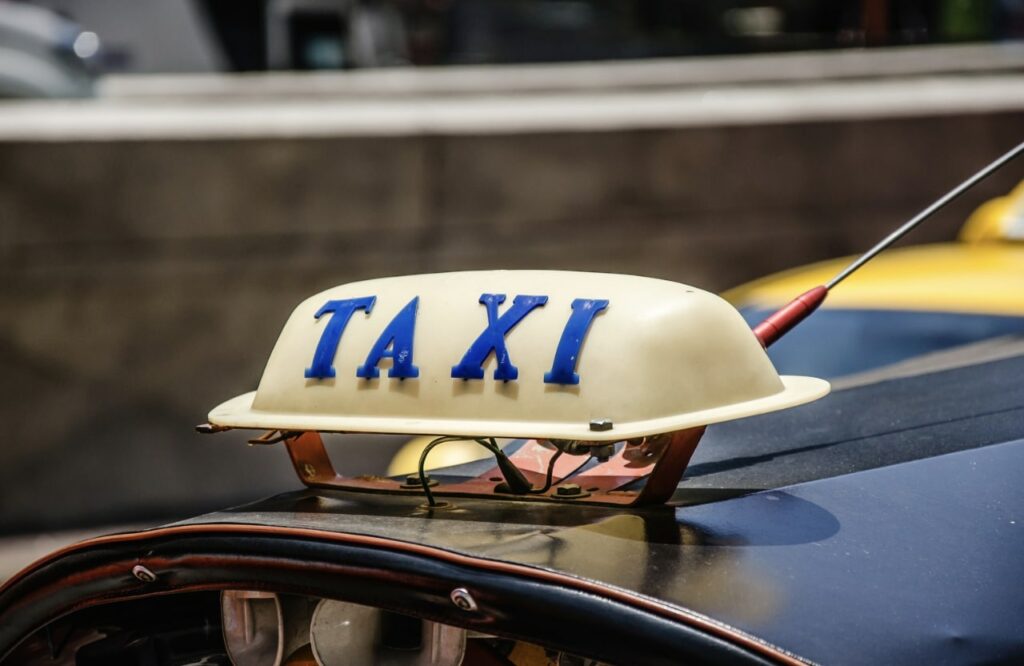
Taxis are a convenient and comfortable mode of transportation in Thailand. They can be found in most cities, including Bangkok, and are a popular choice for travellers who want to avoid the hassle of public transportation.
These taxis in Thailand are metered, which means that the fare is based on the distance travelled. The vehicles are typically air-conditioned and can seat up to four passengers.
Also, they are easily identifiable by their bright colours, such as pink or yellow, and can be hailed from the street or booked in advance.
I find taxis to be a reliable and convenient mode of transportation, especially when I’m travelling with luggage or in a group. However, it’s important to be aware of potential scams and negotiate the fare beforehand.
One of the best things about taxis in Thailand is that they’re metered, which means you don’t have to worry about negotiating the fare beforehand. The flagdown rate for taxis in Bangkok is just 35 baht and the metre increases by 2 baht per kilometre.
| Tips for Riding Taxis in Thailand ⮕ Use the metre – Always insist on using the metre, as it’s the most reliable way to determine the fare. Some taxi drivers may try to negotiate a fixed price, but this is usually more expensive. ⮕ Carry small bills – Taxi drivers may not always have change, so it’s a good idea to carry small bills, such as 20 or 50 baht notes. ⮕ Be aware of scams – Some taxi drivers may try to take advantage of tourists by taking longer routes or pretending not to know the way. Be aware of your surroundings and use a GPS app to track your journey. ⮕ Keep your belongings safe – Always keep your belongings close to you and make sure to lock the doors when travelling in a taxi. |
Using Ride-Hailing Apps in Thailand
With the rise of smartphones and digital technology, ride-hailing apps like Grab have made it even easier for travellers to get around in Thailand.
Here’s what you need to know about ride-hailing apps in Thailand:
- Grab is the most popular ride-hailing app in Thailand, and it’s available in most cities. It offers various services, including taxis, private cars, and motorbikes.
- NaviGo is a new ride-hailing service that launched in Bangkok in early 2022. It aims to provide a more affordable option for both drivers and riders by charging no commission fees to drivers and offering lower fares to riders.
However, as a newer service, it may have limited coverage in certain areas of the city.
- Bolt, formerly known as Taxify, is another ride-hailing service that operates in over 50 countries, including Thailand. It offers services such as taxis, private cars, and motorbikes, and is available in Bangkok, Chiang Mai, and Phuket.
- InDriver is a ride-hailing service that allows riders to negotiate the fare with the driver before the ride starts. It operates in several countries, including Thailand, and is available in Bangkok and Phuket.
While InDriver offers a unique feature of fare negotiation, it may not be as widely available as the other ride-hailing services in Thailand.
| Tips for Riding Ride-Hailing Apps in Thailand ⮕ Using ride-hailing apps are safer and more convenient – Both tourists and locals find that these options are better than hailing a taxi from the street, especially if you’re not familiar with the area. ⮕ You don’t need to negotiate the fare – The fares for ride-hailing apps are typically calculated in the app, so you don’t have to worry about negotiating the fare with the driver. ⮕ Check for available deals – Some ride-hailing apps offer discounts and promotions, so be sure to check for any available deals before booking your ride. |
Motorcycle Taxi
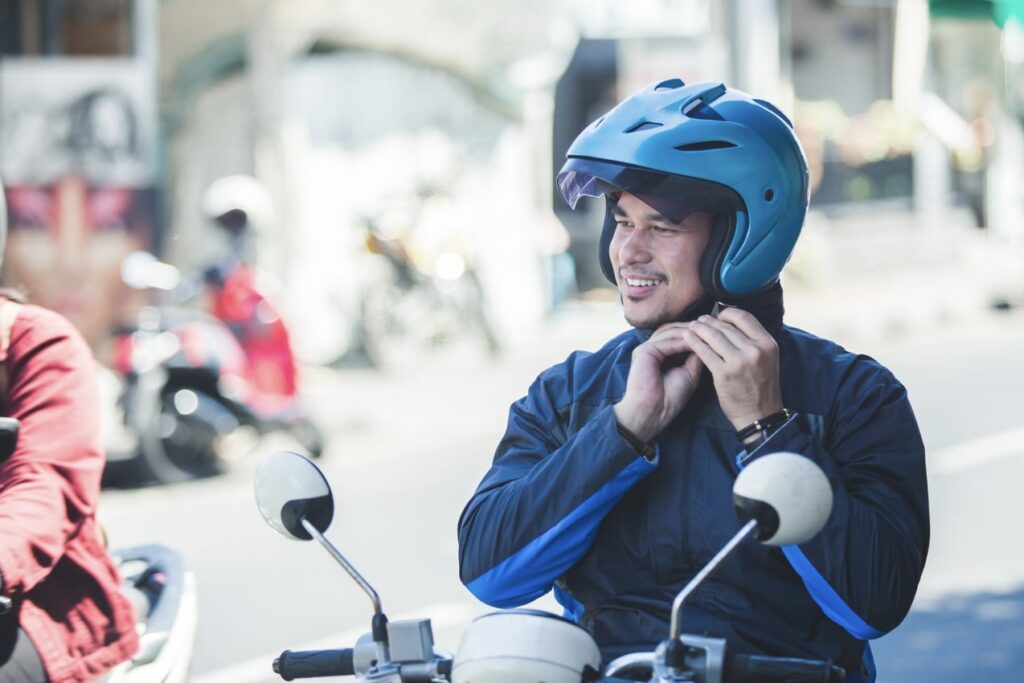
Motorcycle taxis are a fast and convenient mode of transportation in Thailand. They are particularly popular in crowded areas or when travelling short distances.
These taxis in Thailand are usually found at designated stands or can be hailed from the street. They are typically driven by a single driver and can carry one or two passengers.
Moreover, they are a great option for navigating through traffic and reaching destinations quickly.
Personally, I find motorcycle taxis to be a lifesaver when I’m in a rush and need to avoid traffic. They’re quick and efficient, and I love the feeling of the wind in my hair as we zoom through the streets.
| Tips for Riding Motorcycles in Thailand ⮕ Wear a helmet – It’s important to wear a helmet when riding on a motorcycle taxi, as accidents can happen at any time. ⮕ Be aware of safety concerns – Motorcycles can be dangerous, especially in heavy traffic or on poorly maintained roads. Make sure to hold on tight and communicate with your driver if you feel uncomfortable. ⮕ Don’t overload the bike – While some motorcycle taxis may be able to carry two passengers, it’s important not to overload the bike or carry large items, as this can be unsafe. |
Songthaew
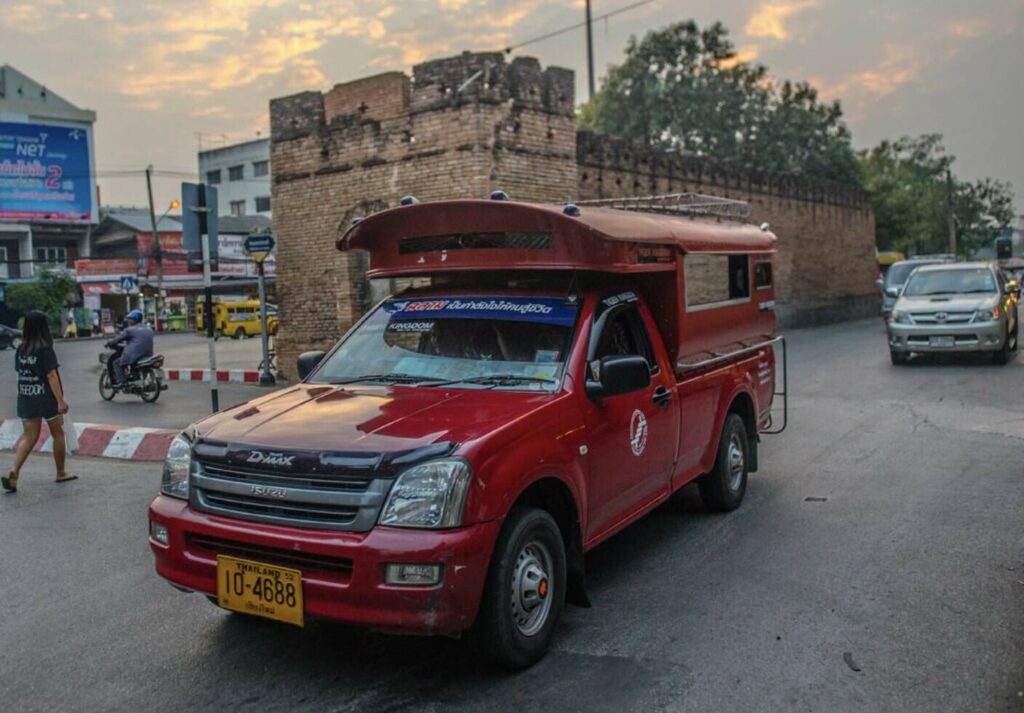
These modified pickup trucks with covered passenger areas and benches in the back are a popular mode of transportation, especially in the northern part of the country.
But how exactly do you ride a Songthaew? Think of them as shared taxis, where you hop in with other passengers going to the same destination.
They don’t have specific stops, but you can wave one down on the side of the road or find them at designated pickup points.
The fare is usually a fixed price, but bargaining is also an option if you’re feeling adventurous. And the best part? Songthaews are one of the most affordable ways to get around Thailand. Fares start at as low as 10 baht!
| Tips for Riding Songthaews in Thailand ⮕ Know your destination – Make sure you know the name and location of your destination before getting on a Songthaew, as the driver may not speak English. ⮕ Be prepared to share – Songthaews are often shared with other passengers, so be prepared to sit close to other people and share the ride. ⮕ Signal when you want to get off – Songthaews may not stop automatically, so make sure to signal to the driver when you want to get off. |
Bus
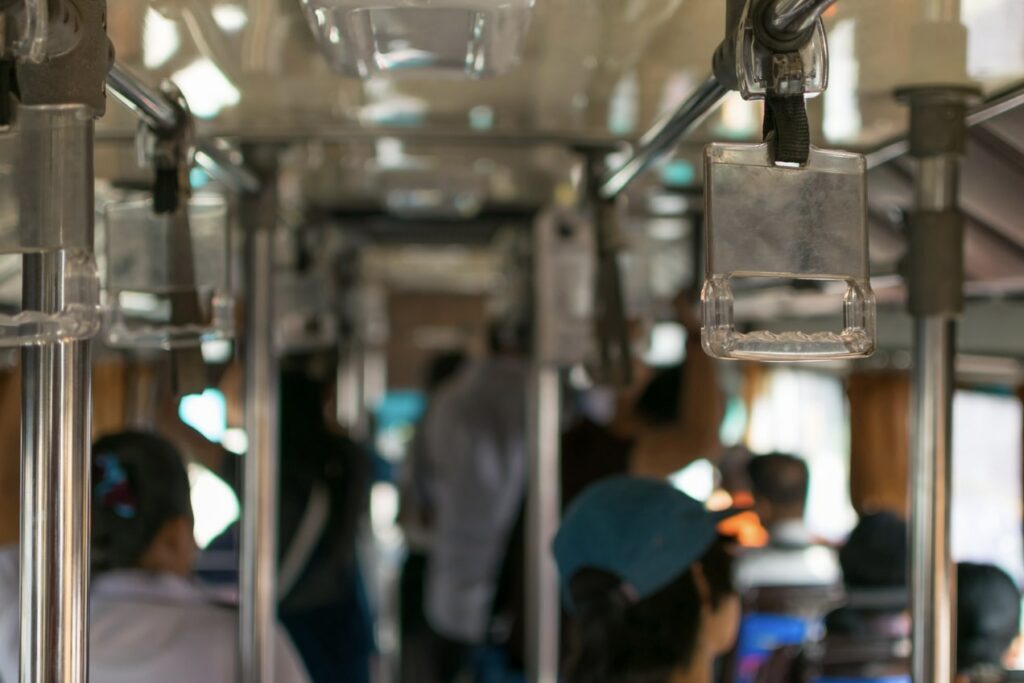
Buses are a popular and affordable mode of transportation in Thailand. They are widely available and offer routes to many destinations, including both short and long-distance journeys.
They come in various sizes and classes, from local buses that stop frequently to long-distance coaches that offer more comfort and amenities.
Also, they typically operate from bus terminals or stations, and the fares are usually fixed based on the distance travelled.
You’ll be pleasantly surprised to find that bus tickets are incredibly affordable, with short trips costing between 10-50 baht (roughly 0.30-1.50 USD) and longer trips reaching a few hundred baht.
When I’m travelling long-distance in Thailand, buses are my go-to option. While the schedules may not be strict, they are usually reliable and offer a more affordable option compared to flying or taking a train.
| Tips for Riding Buses in Thailand ⮕ Check the schedule – Buses in Thailand may not run on a strict schedule, so it’s important to check the departure and arrival times in advance. ⮕ Buy tickets in advance – To ensure a seat and avoid long queues, it’s recommended to buy bus tickets in advance, either online or at the bus station. ⮕ Choose the right class – Depending on the distance and comfort level you prefer, choose the right class of bus. Local buses are the cheapest option but may be crowded and uncomfortable, while long-distance coaches offer more amenities but are more expensive. ⮕ Keep your belongings safe – As with any mode of transportation, it’s important to keep your belongings safe and secure while travelling on a bus ⮕ Don’t sit next to a monk |
Bangkok BTS Skytrain
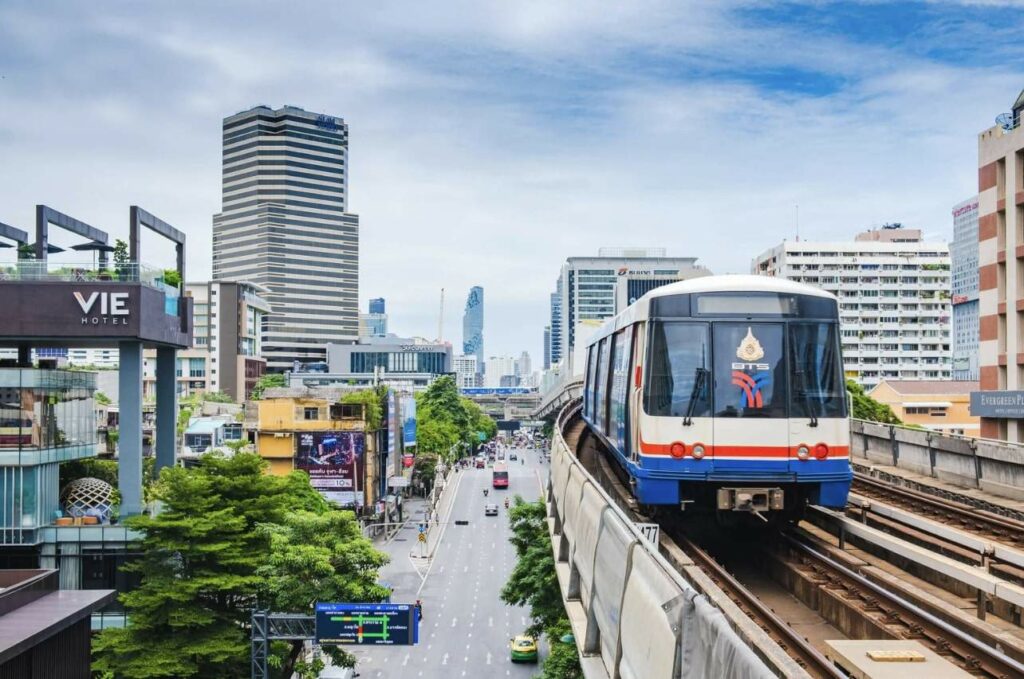
With two lines covering most of the central business district and tourist areas, the BTS Skytrain is one of the most convenient ways to get around Bangkok.
Trains run frequently, with intervals of around 2-3 minutes during peak hours and 5-7 minutes during off-peak hours.
But be prepared for the crowds during rush hour, which runs from 7 AM to 8 PM and 5 PM to 7 PM. While the trains don’t get too packed due to the quick intervals, it can still be a tight squeeze.
Also, note that the stations themselves are not air-conditioned. So, it can get pretty hot and humid on those elevated platforms. But don’t let that stop you from enjoying the convenience of the BTS Skytrain.
Grab a Rabbit Card for even easier access and get ready to explore Bangkok in style!
| Tips for Riding the BTS Skytrain in Thailand ⮕ Buy a Rabbit card – The Rabbit card is a rechargeable smart card that can be used for multiple rides on the BTS Skytrain and other forms of public transportation in Bangkok. It is more convenient and saves time compared to buying a single-trip ticket. ⮕ Avoid peak hours – To avoid crowds and long waits, it’s recommended to travel during off-peak hours, such as mid-morning or early afternoon. ⮕ Be aware of station exits – Some BTS Skytrain stations have multiple exits, so make sure to choose the correct one for your destination. |
Bangkok MRT Subway
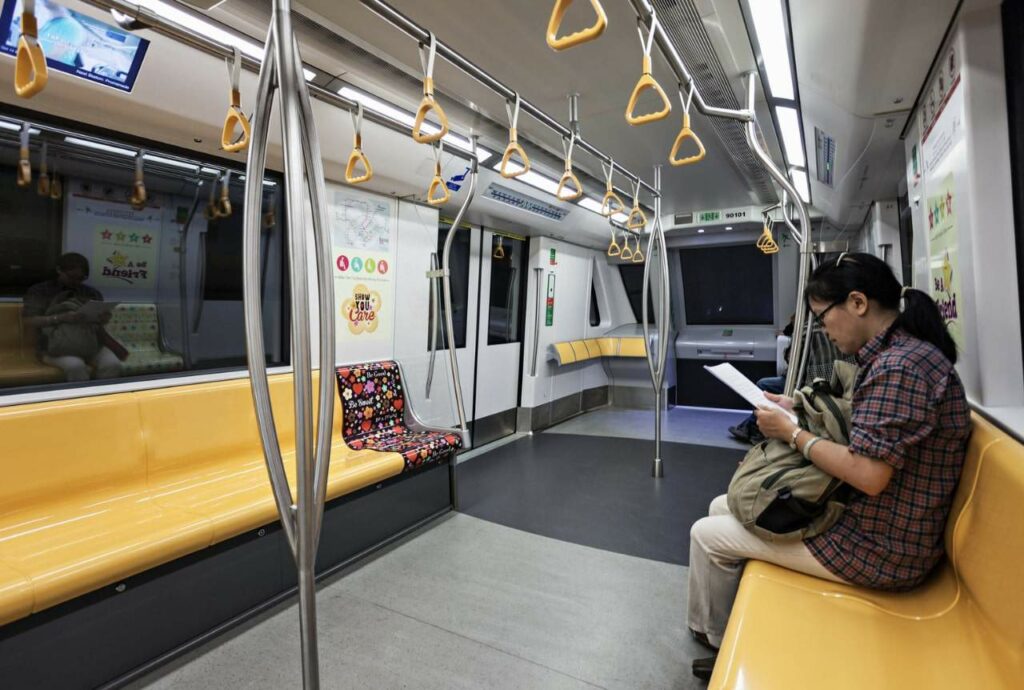
The Bangkok MRT Subway is a rapid transit system that runs underground in Bangkok. It covers several major business districts, shopping areas, and tourist attractions in the city.
The system in Bangkok consists of two lines, the Blue Line and the Purple Line, which cover most of the city’s central areas. The trains run frequently, with intervals of around 5-7 minutes during peak hours and 7-10 minutes during off-peak hours.
Additionally, the BTS Skytrain connects with the MRT subway at Asok, Mo Chit and Sala Daeng stations, providing easy access to even more destinations throughout Bangkok.
You can also hop on the BRT express bus service at Chong Nonsi for a fast and efficient way to get around.
But the fun doesn’t stop there! Change things up and take a ride on the Chao Phraya Express river boat service at Saphan Taksin for a scenic view of Bangkok’s stunning skyline.
Or, for a more unique experience, switch to the Saen Saeb canal boat at Ratchathewi (and other stations) and see Bangkok from a different perspective.
| Tips for Riding the Bangkok MRT Subway in Thailand ⮕ Buy a stored-value card The stored-value card, known as the MRT SmartPass, is a rechargeable smart card that can be used for multiple rides on the MRT Subway and other forms of public transportation in Bangkok. It’s more convenient and saves time compared to buying a single-trip ticket, making it a great choice for tourists exploring Bangkok. ⮕ Be aware of station exits Navigating the MRT Subway in Bangkok is a breeze, but it’s important to be aware of which station exit to take to ensure a smooth journey. Fortunately, exits are clearly marked, making it easy to choose the right one for your destination. Some MRT Subway stations have multiple exits, so be sure to check the station map or ask a staff member for assistance if you’re not sure which one to take. This will save you time and ensure you arrive at your desired location hassle-free. |
Train
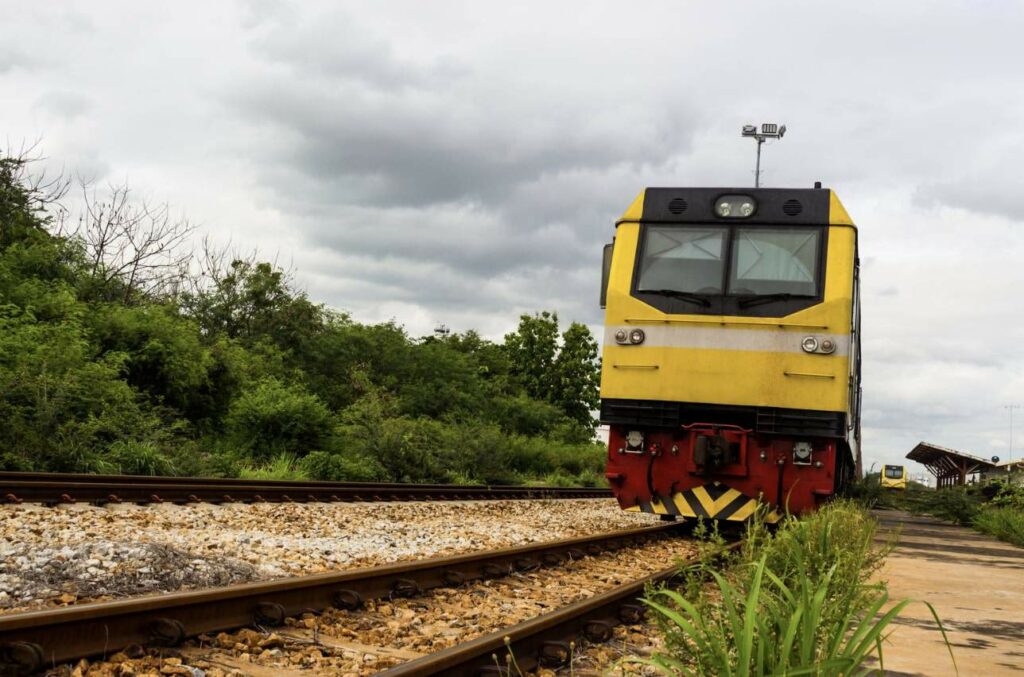
Whether you’re exploring the northern city of Chiang Mai or soaking up the sights and sounds of Bangkok, train travel is a unique and exciting way to experience the country.
And when do I usually take trains? Whenever I go on vacation, of course! Train travel offers a relaxed and scenic way to get to your destination, allowing you to take in the beauty of Thailand at a leisurely pace.
Don’t worry about buying tickets, as they’re easy to purchase at the station or online through the State Railway of Thailand’s website. So pack your bags, grab your camera, and get ready to see Thailand in a whole new way – from the comfort of a train!
If you’re planning to take a train in Thailand, chances are you’ll be passing through Hua Lamphong station in Bangkok. This historic station has been operating since 1916 and is a hub for both local and long-distance trains.
Not only is Hua Lamphong station an important transportation hub, but it’s also a fascinating place to explore. The station’s grand architecture and historic significance make it a popular attraction for tourists.
Inside the station, you’ll find a variety of amenities, including food stalls, souvenir shops, and luggage storage facilities. There’s even a tourist information centre to help you plan your travels.
| Tips for Riding Trains in Thailand ⮕ Book in advance – It’s recommended to book train tickets in advance, especially during peak travel seasons, as the trains can get crowded and the seats may sell out quickly. ⮕ Choose the right class – Consider the length of the journey and your comfort level when choosing the class of seat. The first-class cabins offer more comfort, privacy, and air conditioning, but they are more expensive than the second and third-class seats. ⮕ Bring snacks and drinks – Food and drinks are available on most trains, but they may not always meet your preferences, so it’s a good idea to bring your own snacks and drinks. |
This station in Bangkok has 12 platforms and handles around 130 train departures daily, carrying approximately 60,000 passengers. The railway lines include the Northern Line, North Eastern Line, Southern Line, and Eastern Line.
Each line offers various classes of trains, including express, rapid, and local trains, with different price ranges and travel times.
Flights
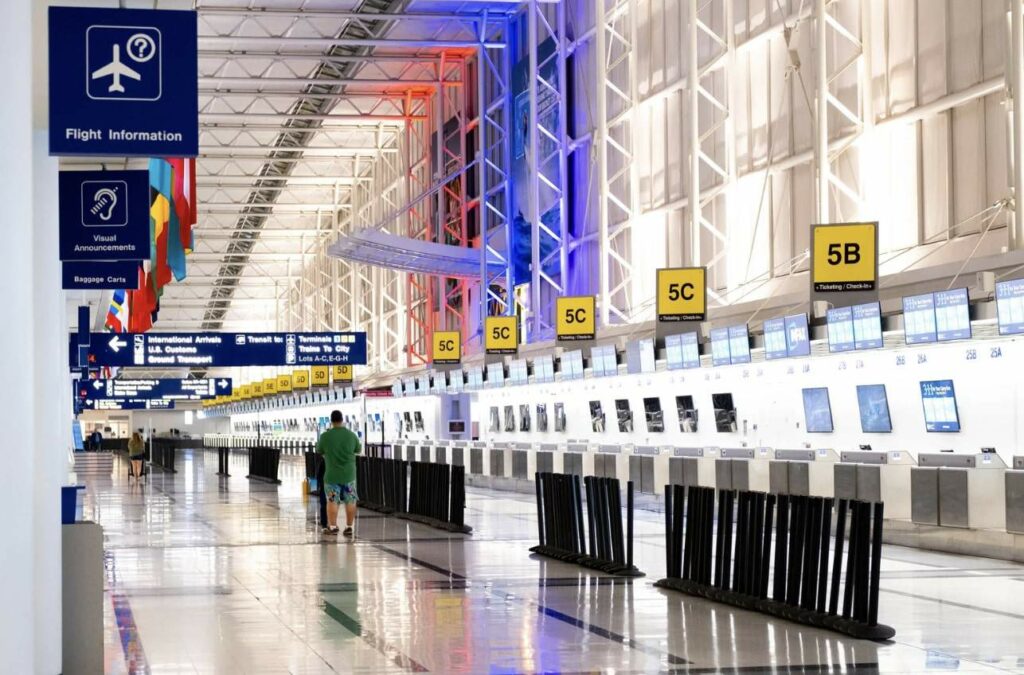
Flights are a fast and convenient way to travel long distances in Thailand, especially when travelling between different regions of the country. There are several domestic airlines that operate in Thailand, including Thai Airways, Bangkok Airways, and AirAsia.
Domestic flights in Thailand are operated by several airlines, and there are numerous airports across the country.
The main international airports in Thailand are Suvarnabhumi Airport and Don Mueang Airport in Bangkok, which also serve as hubs for many domestic flights.
| Tips for Flying in and out of Thailand ⮕ Plan your transportation to the airport Depending on where you’re staying, transportation options to and from the airport may vary. Bangkok has two major airports: Suvarnabhumi Airport and Don Mueang International Airport. Suvarnabhumi is larger and services most international flights, while Don Mueang is typically used for domestic flights and some international low-cost carriers. Make sure to plan your transportation in advance to avoid any last-minute stress, especially if you get stuck in the notorious Bangkok traffic. ⮕ Allow extra time for check-in and security Like most airports, check-in and security procedures at Thai airports can take longer than expected, especially during peak travel times. Arrive early and give yourself plenty of time to get through the airport and to your gate. ⮕ Be aware of baggage restrictions Most airlines in Thailand have strict baggage restrictions, especially for carry-on luggage. Check your airline’s website or contact them directly to confirm their baggage policies before your flight. ⮕ Choose the airport that’s best for you As mentioned earlier, Bangkok has two major airports. If you’re flying internationally or need to transfer to another flight, Suvarnabhumi may be your best bet. If you’re travelling domestically or flying with a low-cost carrier, Don Mueang may be a better option. Consider your itinerary and choose the airport that best suits your needs. ⮕ Bring some local currency While most airports in Thailand have currency exchange booths and ATMs, it’s always a good idea to have some local currency on hand in case you need to purchase food, water, or other essentials before or during your flight. |
Ferries and Boats
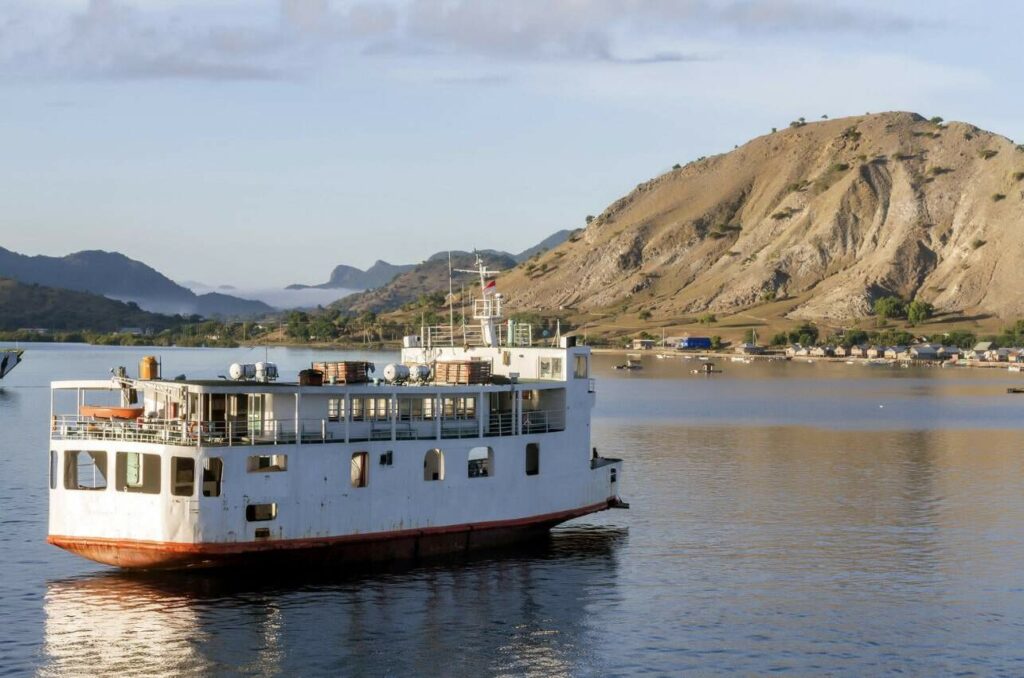
Ferries and boats are a popular mode of transportation in Thailand, especially when travelling to the islands in the Gulf of Thailand or Andaman Sea. They offer scenic views of the ocean and can be a fun and unique way to travel.
In addition to being a fun way to sightsee, the Chao Phraya Express Boat can also be a convenient mode of transportation. With stops at major tourist destinations, you can easily hop on and off to explore the city at your own pace.
Some boats also offer more luxurious options, such as private cabins or VIP seating, which can be a bit more expensive but provide a unique and comfortable experience.
Personally, I love taking the Chao Phraya Express Boat when I’m in Bangkok. It’s a relaxing and enjoyable way to see the city from a different perspective, and it’s always a highlight of my trips to Thailand.
| Tips When Travelling with Ferries/Boats in Thailand ⮕ Consider using the Chao Phraya Tourist Boat – This is a great option for tourists, as it stops at most of the major tourist attractions along the river and offers an open-deck area. Know the pier numbers – Most Chao Phraya River piers are numbered, so it’s important to know the pier number of your destination to ensure that you don’t miss it. ⮕ Beware of scams – Be wary of scammers who may offer to sell you tickets at inflated prices or offer to take you on private tours. Stick to purchasing tickets at the official desks at the piers. |





